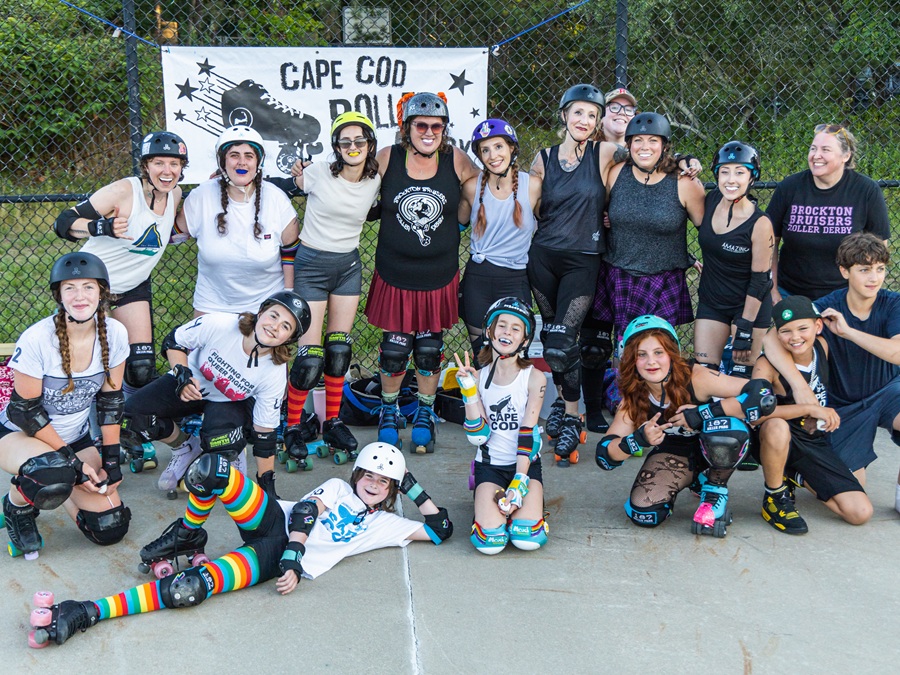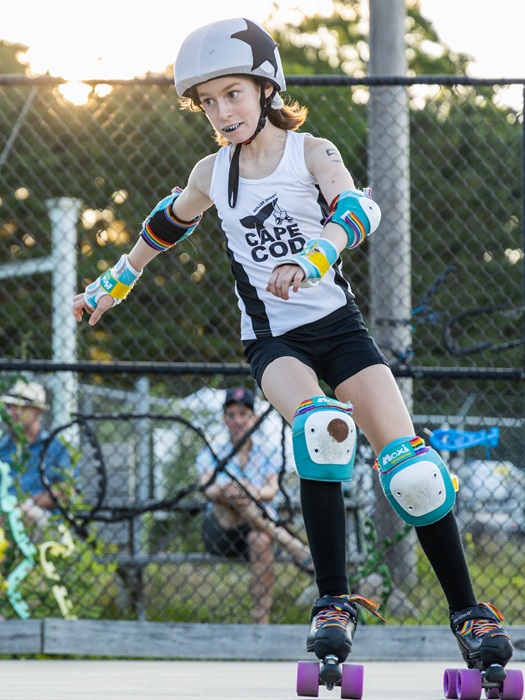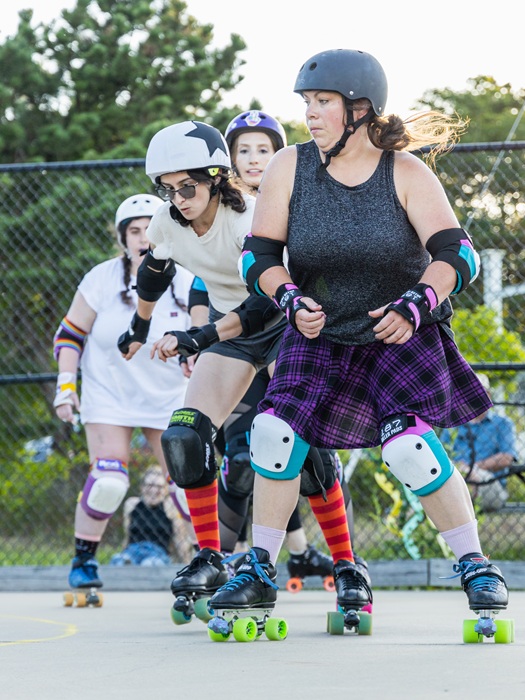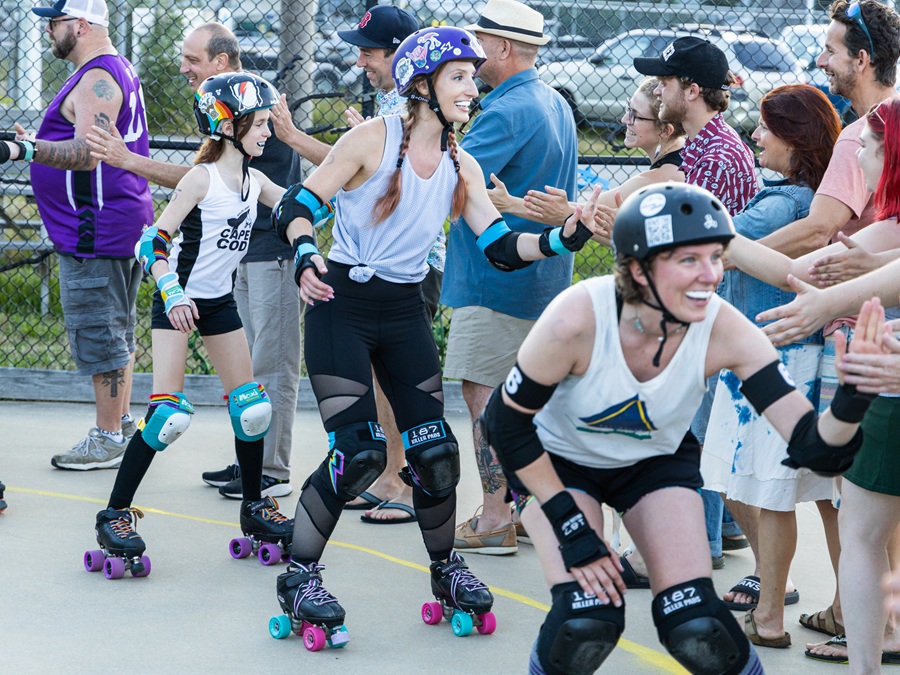ORLEANS — Take it from Mean Mimi, Devil Velvet, and Tippi Longstocking: you don’t need ice to go skating at the Charles Moore Arena. The skaters, along with the other members of the Cape Cod Roller Derby team, have monthly scrimmages there during the summer with members of the Brockton Bruisers, who make the long drive for an hour or so of controlled, wheel-footed chaos.
Those aren’t the names their parents gave them, but in roller derby, as in superhero movies, it’s the chosen alias that counts. The Bruisers’ Sylvia Wrath, Foxycodone, and Arson Nic were among those who donned helmets and kneepads to challenge the Cape’s best and boldest roller skaters at their July 19 match.

For the uninitiated: a roller derby match (or “bout”) takes place over a series of two-minute periods called “jams,” during which skaters from each of two teams skate laps around an oval track. One player from each side — the “jammers” — score points for their teams whenever they skate past an opponent. If you’re not a jammer you’re a blocker. That job is to hinder the opposing team’s skaters so that your jammer can score.
Just what moves blockers can make to prevent other skaters from rolling free depends on the jam’s designated contact level. Roller derby is a contact sport, but Cape Cod Roller Derby varies the contact level from jam to jam to make the bout more friendly to newcomers.
A level-1 jam allows minimal contact, with jammers usually weaving past the skaters who slow down to block them. In a level-2 jam, blockers link arms to create barriers for opposing jammers, who then need to skirt around them fast or duck underneath. A level-3 jam is full-contact, with skaters using their hips and shoulders to knock each other out of bounds.

There isn’t a set number of jams that happen during a typical bout, but the one at the Charles Moore Arena in July was played in 18 periods, six for each level. The mix makes for a less intense game than most high-profile matches, says organizer Emma “Cha-Cha” Levy. Those tend to be longer and are played full-contact all the way through, with five skaters from each team competing in each jam.
The July bout, by contrast, played on a shorter track, was a “pickup version” of the sport, Levy says. The Brockton and Cape Cod teams combined into one, then split into two mixed eight-player teams, one wearing white and one wearing black.
The white-jersey-wearing team won 40-50, but Levy is more interested in popularizing the sport than figuring out who’s the best player.
Levy, who lives in Barnstable, gives roller skating classes a few times a week at the Moore Arena to train prospective team members; she also holds open skate events there. The next one is scheduled for Saturday, Aug. 30 at 5 p.m.

Right now, there are 19 people on the Cape team: eight children and 11 adults. Levy says she would need about 40 members to reliably field teams for bouts. That’s why the Brockton Bruisers have joined the scrimmages. Together, the teams can form two eight-player scrimmage groups of roughly equal experience without too much trouble.
Levy learned roller derby shortly after the Cape Cod team was organized in 2013. “I was a street rat in the late ’70s and early ’80s,” she says. But she hadn’t worn the wheels for a long time when she joined the team. It did her good, she says: “I signed up, and from there, everything that was wrong in my life became right.”
“Cha Cha” is a shortened version of Levy’s original derby name, “Emma Getcha.” She says the nickname fits because she likes to dance.
For Levy, roller derby is a philosophical sport. The game “makes people understand you have to take up space,” she says. Even when teams don’t play full-contact, athletes must become aware of where they are in relation to each other. That feeling can be empowering, Levy says.
“Sometimes the world makes a woman want to feel really little,” she says. “But no matter what body shape you have, no matter who you are, you have a wonderful ability and power in you to take up space.”

While many organized roller derby leagues are open to women only, boys are welcome on the Cape Cod team. Two showed up at the bout on July 19, one of them Levy’s 14-year-old son, Howard “Lightning” Dubner; the other, 11-year-old Viggo “Flyin’ V” Bossi of Woods Hole, who won a “most valuable jammer” award from his opponents after the match.
Bossi says being a good jammer takes courage. “You have to know that you can get hurt at any given moment, and you just gotta shrug it off,” he says.
Astrid “Disastrid” Photos, of Cotuit, won the other “most valuable jammer” award. She got her first pair of skates at age eight and joined the roller derby about a year later; she, like, Bossi, is 11 now.
Photos says being a good jammer is mostly about speed. She says she isn’t very good at using her toe stops yet, but she’s working on it. She says she likes being on the team because “roller derby is a place where you can be whoever you want to be.”
Levy says it’s way better than other contact sports. “Quite honestly,” she says, “football’s super boring.”
